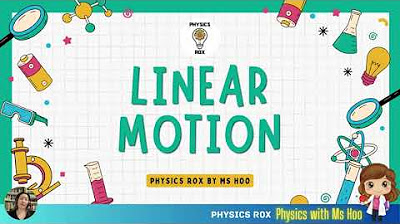Gerak Benda dan Makhluk Hidup di Lingkungan Sekitar
Summary
TLDRThis educational video explores the concept of motion, focusing on straight-line motion and the relationships between distance, speed, velocity, and time. The script discusses key concepts such as distance versus displacement, the difference between speed (scalar) and velocity (vector), and how acceleration occurs during varying motion. It delves into types of linear motion, including uniform motion (GLB) and uniformly accelerated motion (GLBB), explaining each with examples and mathematical formulas. The video concludes with practical problems on calculating speed and acceleration, emphasizing the real-world application of these concepts.
Takeaways
- 😀 Objects are considered in motion if they experience a change in position relative to a reference point.
- 😀 Distance refers to the total path an object travels, while displacement is the change in position from the starting point to the end point.
- 😀 Distance is a scalar quantity (only magnitude), while displacement is a vector quantity (magnitude and direction).
- 😀 Speed is the ratio of distance to time, and it is a scalar quantity that does not consider direction.
- 😀 Velocity is the rate of change of displacement, and it is a vector quantity, which means it has both magnitude and direction.
- 😀 Acceleration is the rate of change of velocity over time, and it can be either positive (speeding up) or negative (slowing down).
- 😀 In Uniform Linear Motion (GLB), an object moves with constant speed, while in Uniformly Accelerated Linear Motion (GLBB), an object's speed changes at a constant rate.
- 😀 Gravitational acceleration is a constant value, approximately 9.8 m/s², or often rounded to 10 m/s², affecting objects in vertical motion.
- 😀 The formula for speed is: Speed = Distance ÷ Time, and it is measured in meters per second (m/s).
- 😀 The formula for acceleration is: Acceleration = (Final velocity - Initial velocity) ÷ Time taken.
- 😀 In real-world scenarios, such as driving, changes in speed due to factors like traffic lights demonstrate how velocity and acceleration can vary continuously.
Q & A
What is the definition of motion?
-Motion is the change in position of an object relative to a reference point.
What is the difference between distance and displacement?
-Distance is the total path length traveled by an object, while displacement is the change in position from the starting point to the ending point. Distance is a scalar quantity (no direction), and displacement is a vector quantity (with direction).
How can speed and velocity be differentiated?
-Speed is the rate at which an object covers distance, and it is a scalar quantity (magnitude only). Velocity is the rate at which an object changes its position, and it is a vector quantity (includes both magnitude and direction).
What is the significance of acceleration in motion?
-Acceleration refers to the change in velocity of an object over time. Positive acceleration means speeding up, and negative acceleration (deceleration) means slowing down.
What are the two types of linear motion discussed in the video?
-The two types of linear motion discussed are GLB (Gerak Lurus Beraturan), or uniform motion, and GLBB (Gerak Lurus Berubah Beraturan), or uniformly accelerated motion.
What is GLB (Gerak Lurus Beraturan)?
-GLB refers to uniform motion, where the object moves at a constant speed without any change in velocity over time.
What does GLBB (Gerak Lurus Berubah Beraturan) represent?
-GLBB refers to uniformly accelerated motion, where the object experiences a constant change in speed, either speeding up or slowing down, over time.
How is speed calculated mathematically?
-Speed is calculated using the formula: Speed = Distance / Time.
How is acceleration calculated?
-Acceleration is calculated using the formula: Acceleration = (Final Velocity - Initial Velocity) / Time.
What is the value of gravitational acceleration (g)?
-The acceleration due to gravity (g) is approximately 9.8 m/s² or often rounded to 10 m/s².
Outlines

Esta sección está disponible solo para usuarios con suscripción. Por favor, mejora tu plan para acceder a esta parte.
Mejorar ahoraMindmap

Esta sección está disponible solo para usuarios con suscripción. Por favor, mejora tu plan para acceder a esta parte.
Mejorar ahoraKeywords

Esta sección está disponible solo para usuarios con suscripción. Por favor, mejora tu plan para acceder a esta parte.
Mejorar ahoraHighlights

Esta sección está disponible solo para usuarios con suscripción. Por favor, mejora tu plan para acceder a esta parte.
Mejorar ahoraTranscripts

Esta sección está disponible solo para usuarios con suscripción. Por favor, mejora tu plan para acceder a esta parte.
Mejorar ahoraVer Más Videos Relacionados

Linear Motion - Distance, Displacement, Speed, Velocity, Acceleration - SPM & IGSCE Physics

Gerak Lurus • Part 1: Gerak Lurus Beraturan (GLB) dan Gerak Lurus Berubah Beraturan (GLBB)

Il moto rettilineo uniforme - Spiegazione e esempi

DESCRIBING MOTION: DISTANCE AND DISPLACEMENT | SCIENCE 7 QUARTER 3 MODULE 1

Movimento Retilíneo Uniforme - teoria e exemplo resolvido

IGCSE Physics [Syllabus 1.2] Motion
5.0 / 5 (0 votes)
